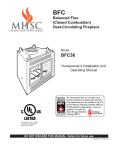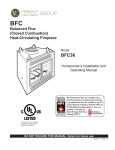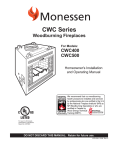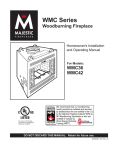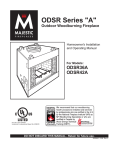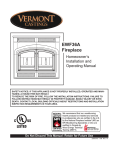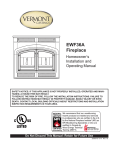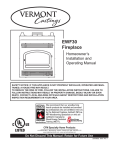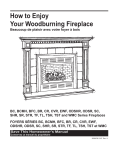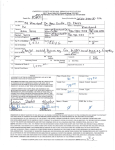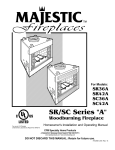Download Vermont Casting 647 BFC Indoor Fireplace User Manual
Transcript
BFC Balance Flue (Closed Combustion) Heat-Circulating Fireplace Model: BFC36 Homeowner’s Installation and Operating Manual 647 BFC cover 8/18/00 djt For use in the U.S. / Canada Underwriter’s Laboratories Report No. MH6018 CFM Specialty Home Products 410 Admiral Blvd. • Mississauga, Ontario, Canada L5T 2N6 • 905-670-7777 www.majesticproducts.com • www.vermontcastings.com DO NOT DISCARD THIS MANUAL: Retain for future use. 7412647 8/05 Rev. 10 BFC36 Balance Flue Heat-Circulating Fireplace Safety Information Please Read This Manual Before Installing and Using Fireplace IMPORTANT: Read all instructions and warnings carefully before starting installation. Failure to follow these instructions may result in a possible fire hazard and will void the warranty. Burn only solid wood fuel or gas logs. Description The BFC36 is intended for operation only with the doors closed. The BFC36 fireplace is a solid fuel, woodburning fireplace. The BFC36 is a balanced flue (closed combusDo not install a solid fuel burning insert or other tion) heat-circulating fireplace which receives outside products not specified for use with this fireplace. combustion air through the chimney system. This fireplace is not approved for installation in mobile homes. Precautions WARNING: Check with your electronics manufacturer before installing a television or other electronCFM Specialty Home Products fireplaces and comic device above this fireplace. ponent parts have been highly tested and will operate safely when installed in accordance with instructions Proposition 65 Warning: Fuels used in gas, woodprovided in this manual. Carefully read and understand burning or oil fired appliances, and the products of all instructions before beginning installation. combustion of such fuels, contain chemicals known If you notice any damage to fireplace or component to the State of California to cause cancer, birth departs, immediately report damage to your Vermont fects and other reproductive harm. Castings, Majestic Products dealer. California Health & Safety Code Sec. 25249.6 Only use CFM Corporation components or the warranty will be voided and a fire hazard may be created. Drafts CFM Specialty Home Products warranty will be voided by and CFM Specialty Home Products disclaims any responsibility for the following actions: • Installation of any damaged fireplace or chimney component; • Modification of fireplace, chimney assembly or any component parts thereof; (except for chase flashings as detailed in CFM Corporation Chimney Top installation instructions). The fireplace should not be located in areas that create drafts (ie: frequently opened doors and central heating air inlets/outlets) that hamper the normal flow of air into the fire. Gas Logs If you plan to install a gas log, the gas line should be installed before framing the fireplace. The gas line must be installed by a certified gas line installer. • Installation other than as instructed by CFM Specialty Home Products; or • Installation and/or use of any component part not manufactured or approved by CFM Specialty Home Products in combination or assembly with a CFM Specialty Home Products fireplace system, notwithstanding any independent testing laboratory or other third party approval of such component parts or accessory. Any such action may possibly cause a fire hazard. Consult local building codes to ensure that you are in compliance before installing the fireplace. This fireplace and chimney system must be vented to the out-of-doors. Do not obstruct or modify air inlets/outlets in any manner. Do not install combustible materials on any of the black fireplace surround. 2 BFC36 Listed UL127 / ULC-S610 Standard for Factory Built Fireplaces Unit: WABD3J0 Table of Contents Safety Information .................................... 2 Specifications and Framing ..................... 3 Parts Identification ................................... 5 Chimney Requirements ........................... 6 Planning Information ................................ 7 Installation ............................................... 8 Replacement Parts ................................. 19 Accessories ........................................... 20 7412647 BFC36 Balance Flue Heat-Circulating Fireplace BFC36 Balanced Flue Heat-Circulating Fireplace ������" (624mm) Rough ����" Opening (197mm) Depth 51����" (1297mm) ���" (13mm) Rough Opening Width 43" (1092mm) �����" (179mm) �� ���" Rough Opening Height ��� �" ( �� ��� "( 51����" (1297mm) 91 � 18 ��" ( 34 16 m mm m ) ) 8m m ) ��" (610mm) 23" (584mm) 13���" Dia. (343mm) 11" Dia. (179mm) 8" Dia. (203mm) ���" Recessed (16mm)Nailing Flange �����" (902mm) 35" (889mm) Gas Line Access 39���" (997mm) ��" ������" (246mm) (279mm) 32���" (829mm) ��" (533mm) 36" (914mm) ��" (914mm) 41���" (1064mm) �������" (49mm) Gas Line Access ������" (176mm) Fig. 1 BFC36 specifications and framing. 647 BFC36 specs Width Back 8/18/00 djt B BFC36 Front A 32¹⁄₂" (826 mm) Width B 20⁷⁄₁₆" (519 mm) Depth C 17³⁄₄" (451 mm) C A FP1531 Fig. 1a Hearth dimensions. FP1531 hearth dimensions 9/04 djt 7412647 3 BFC36 Balance Flue Heat-Circulating Fireplace Termination Cap Storm Collar Pan Flashing Batt Insulation (Cut out around firestop) Draftstop Firestop Ceiling Level Standoff Trim Ledge Standoff Surround Glass Door Gas Line Access Hole (Each Side) Romex Pigtail Gas Line Access Knockout (Each Side) Air Inlet Basket Grate Bottom Grille Top Grille and Air Outlet Metal Safety Strip(s) Shown not inplace (1,2 or 3 pieces) Nailing Flange FP554c Fig. 2 Fireplace and chase parts identification. 4 FP554a BFC Fireplace and chase parts identification circulating model 8/21/00 djt 7412647 BFC36 Balance Flue Heat-Circulating Fireplace Chimney Requirements - Offset Installations OFFSET CHIMNEY FLUE EXIT RISE Chimney Section A D E 6 FT. C G 30° Offset Elbow Rise Offset H 30° Return Elbow 30° Offset Elbow B 30˚ Elbow Offsets G TCS8A Support H Hearth Floor Example 1 Example 2 Notes: G + H cannot exceed 20 feet. Air Space Clearances: = 2” Min. to Combustibles Illustration Key Example 3 FP269 FP269 The following safety rules apply to offset installations (letters correspond with illustration above): C. The chimney cannot be more thanMBUF 30˚ 5/16/96 (45˚ in Canada) from the vertical plane in5/25 rev. any installation*. A. Height of the chimney is measured from the hearth to the chimney exit. D. The maximum length of the angled run of the total chimney system is 20 feet. (G plus H cannot exceed 20 feet.) Maximum: Minimum: Without Elbows With 2 Elbows* With 4 Elbows* BFC36 50’0” 14’6” 14’6” 21’0” B. Do not use more than 4 elbows per chimney. Attach the straps of the return (top) elbow to a structural framing member. The offset (first) elbow of any pair does not have straps. E. A chimney support (Model TCS8A) is required every 6 feet of angled run of chimney. Chimney supports are required for every 30 feet and 60 feet of vertical chimney height above the hearth. Determine the offset distance of your chimney arrangement from the centerline of the fireplace to the centerline of the chimney where it is to pass through the first ceiling. NOTE: This offset distance may not be your full offset distance. See Examples 2 and 3. 1’ 1¹⁄₂' 3’ 4’ 0 1 0 2 1 0 2 0 0 1 0 0 1 0 0 0 0 0 0 0 0 0 0 0 0 0 0 0 0 0 0 0 0 0 0 0 0 0 0 0 0 0 1 0 1 0 1 0 1 0 1 0 1 0 1 0 1 0 1 0 1 0 1 0 1 0 1 0 1 0 1 0 1 0 1 0 1 0 1 0 0 0 0 0 0 1 0 0 1 0 0 2 0 1 2 0 1 3 0 2 3 1 2 0 1 3 0 2 3 1 2 0 1 3 0 2 3 1 2 0 0 0 0 0 0 0 0 1 0 1 1 0 1 1 0 2 1 0 2 1 0 2 1 3 2 1 3 2 1 3 2 4 3 2 4 3 2 4 3 5 Chimney Support Elbow B IWF282 30° Return Elbow 0 0 0 0 0 0 0 0 0 0 0 0 1 1 1 1 1 1 1 1 1 1 1 1 2 2 2 2 2 2 2 2 2 2 2 2 3 3 3 3 FP282 MBUF Offset 5/26/96Rise 3” 8¹⁄₄" 11¹⁄₄" 13¹⁄₂" 16¹⁄₂" 20¹⁄₄" 21³⁄₄" 26¹⁄₄" 28¹⁄₂" 31¹⁄₂" 34¹⁄₂" 37¹⁄₂" 41¹⁄₂" 45" 47¹⁄₄" 51" 53¹⁄₄" 56¹⁄₄" 59¹⁄₄" 62¹⁄₄" 64¹⁄₂" 68¹⁄₄" 70¹⁄₂" 74¹⁄₄" 78" 81" 84" 87" 89¹⁄₄" 93" 95¹⁄₄" 99¹⁄₄" 101¹⁄₄" 104¹⁄₄" 107¹⁄₄" 110¹⁄₄" 114" 117³⁄₄" 120" 123³⁄₄" 11” 20" 25¹⁄₄" 29¹⁄₄" 34¹⁄₄" 40³⁄₄" 43¹⁄₂" 51¹⁄₄" 55¹⁄₄" 60¹⁄₄” 65¹⁄₂" 70³⁄₄" 77³⁄₄" 83³⁄₄" 87¹⁄₂" 94" 98" 103¹⁄₄" 108¹⁄₂" 113¹⁄₂" 117¹⁄₂" 124" 128" 134¹⁄₂" 140³⁄₄" 146" 151¹⁄₄" 156¹⁄₂" 160¹⁄₄" 166³⁄₄" 170³⁄₄" 177³⁄₄" 181³⁄₄" 186¹⁄₄" 191¹⁄₂" 196³⁄₄" 203¹⁄₄" 209³⁄₄" 213¹⁄₂" 220" Fig. 3 Chimney system requirements. 7412647 5 BFC36 Balance Flue Heat-Circulating Fireplace Planning Information Preplanning an installation is very important to ensure safety and to save time and money. An installer must predetermine where a fireplace will be set and how the chimney system will be run. Mounting the Fireplace A fireplace may only be mounted on the following surfaces: 1. A flat combustible surface. 2. A raised wooden platform. 3. A concrete block or other solid object placed beneath each of the four (4) corners of the fireplace. The fireplace must be spaced 1” (25mm) from a combustible back wall and 1/2” (13mm) from a combustible side wall or support. (Page 13, Fig. 17) Planning the Chimney Run LT L1 L1 TRIPLE WALL 81 818 83 84 TOTAL INSTALLED LENGTH LENGTH (LT) (L1) 11¹⁄₂" 17¹⁄₂" 35¹⁄₂" 47¹⁄₂" 10¹⁄₂" 16¹⁄₂" 34¹⁄₂" 46¹⁄₂" The Ten Foot Rule Major U.S. building codes specify a minimum chimney height above the roof top. The “Ten Foot Rule” is a fire safety rule and not a draft rule. To ensure proper draft, it is recommended that you always meet or exceed the “Ten Foot Rule,” especially when installing a termination on a high pitch roof. (Fig. 5) The key points of the “Ten Foot Rule” are: 1. If the horizontal distance from the chimney to the peak of the roof is 10’ (3m) or less, the top of the chimney must be at least 2’ (610mm) above the peak of the roof, but never less than 3’ (914mm) in height above the highest point where it passes through the roof. 2. If a horizontal distance from the chimney to the peak of the roof is more than 10’ (3m), a chimney height reference point is established on the surface of the roof a distance of 10’ (3m) from the chimney in a horizontal plane. The top of the chimney must be at least 2’ (610mm) above the reference point, but never less than 3’ (914mm) in height above the highest point where it passes through the roof. 0 To 10' 2' Min. FP288a Determine how the chimney will be run, length of run FP288A and chimney components required to complete the MBUF-INSTALLED LENGTH wall job. (Fig. 4) Never install a chimney belowTriple minimum 1/28/99 djt heights. In planning a chimney system, it is important to know: 1. The height of a chimney is measured from the hearth to the exit point on the termination. 2. A chimney cannot be offset more than 30° from a vertical plane. 3. A chimney may run straight up or it may be necessary to offset it to avoid obstructions. 4. The maximum length of an angled run (total chimney system) is 20’ (6m). 5. No more than 2 offsets (4 total 30° elbows in U.S./or 2 total 45° elbows in Canada) per fireplace may be used. 6. A guy wire stabilizer is required for chimneys extending more than 6’ (1.8m) above a roof line. 6 0 To 10' 3' Min. Fig. 4 Installed lengths of chimney sections. 2' Min. 3' Min. Reference Point AC246 Fig. 5 Ten Foot Rule illustration. AC246 4/1/96 7412647 BFC36 Balance Flue Heat-Circulating Fireplace Chimney Supports The chimney system is supported by the fireplace for vertical chimney heights less than 30’ (9m) above the hearth. Chimney supports are required if the vertical height exceeds 30’ (9m). Locate chimney supports at ceiling holes or other structural framing at 30’ (9m) heights. Spacing between chimney supports must not exceed 30’ (9m). Use Chimney Support Model TCS8A. (NOTE: The TCS8A cannot be mounted directly to the fireplace.) Support provided by elbow straps fulfills the support requirement only if they are spaced as previously described. (A chimney support is 2¹⁄₂" (64mm) long when installed.) Angled chimney runs require a support every 6’ 1.8m) in addition to the elbow straps. Chimney supports are used for this function. (Fig. 6) Installation Insulating Fireplace Enclosure for Cold Climates If you live in a cold climate, it is not required but highly recommended that you insulate fireplace enclosure to eliminate cold air penetration as much as possible. Insulate base of fireplace with a noncombustible insulation rated for a minimum of 300°F. Insulating is very important for outside wall installations over a concrete slab. If fireplace is installed on a platform, insulation should be placed on top of the platform before fireplace is set. (Fig. 7) When a fireplace is installed in a chase or on a outside wall, enclosure should be treated like any outside wall in a home. Insulation should be installed on the inside wall as well as the outside wall(s). In a chase, it is also a good idea to install a firestop at the first ceiling level above the fireplace and enclose the chase with sheeting material. Insulation may then be installed above sheeting material to assure the space around the fireplace is totally protected. (Fig. 2) Chimney Support Strap When installing the chimney, DO NOT caulk between outer pipe and firestop. It is vital that some air be allowed to flow through this very thin gap. TCS8A FP284a Fig. 6 Chimney support installation. CAUTION: When installing a fireplace in an insulated enclosure, be sure all required air spaces are maintained. (Page 13, Fig. 17) Chase Installation A chase is a vertical box-like structure which encloses FP284a the fireplace and/or chimney. Chases are typically built TCS8Acut on the outside of the house with fireplace opening into the outer wall of a room. (Page 4, Fig.8/21/00 2) If you need help in determining fireplace location or how the chimney system should be run, contact your Vermont Castings, Majestic Products dealer for assistance. 7412647 7 BFC36 Balance Flue Heat-Circulating Fireplace Hard Flat Surface NOTE: Check local building codes to determine if junction box is required at the romex pigtail/house wire connection Also check junction box and speed control (SCVS) installation instructions. The Model FKSX-A blower assembly is preinstalled in the BFC36. Fireplace Electrical Coverplate Romex Pigtail (Provided) Wire Nuts (Not provided) Insulation Black Platform Ground White FPC555a FP1062 Fig. 7 Insulating between platform and fireplace. Framing FPC555a Framing can be constructed beforePlatform or after the fireplace insulation is set in place, however, most installers build the BFC model frame before setting the fireplace. 8/21/00 djt Frame fireplace with 2 x 4 lumber or heavier materials. Refer to framing dimensions in Figure 1 for basic fireplace specifications. NOTE: Framing should be positioned to accommodate wall covering and fireplace facing material. Installing Electrical Wire The fan requires 120VAC, 60 Hz power which may be connected to the right side of the fireplace using the romex pigtail provided with teh unit. This power must be completed before the fireplace is secured and finish material applied. 1. Attach the white wire from house power to the white wire of the romex pigtail and secure with a wire nut. 2. Attach the black wire from the house power to the black wire of the romex pigtail and secure with a wire nut. 3. Attach the ground wire from house power to the ground wire of the romex pigtail and secure with a wire nut. (Fig. 8) IMPORTANT: The wire nuts must be tight. 8 House Wiring (120V 60Hz) Fig. 8 Wiring diagram. Chimney Set-up FP1062 romex pigtail 8/21/00 djt Since you have already preplanned the chimney run, you should know exactly how the installation is to be accomplished — how much pipe is required, the number of elbows, if any, and type of termination to be used. CAUTION: REPORT TO YOUR DEALERS ANY PARTS DAMAGED IN SHIPMENT, SPECIFICALLY CHECK THE END CONNECTION OF CHIMNEY SECTIONS AND ELBOWS. NOTE: The BFC36 fireplace must use CFM Corporation Model triple wall 8” chimney components only. The installation procedure described in this manual applies only to this system. Straight-Up Chimney Installation To mark the centerline of the flue, put the fireplace in final position and measure out from the wall: 8³⁄₄" (222mm). Mark a spot on the ceiling directly above the fireplace. Draw a line parallel to the back wall through this mark. (Fig. 9) Using a plumb bob positioned directly over center point of fireplace flue collar, mark the ceiling to establish the chimney center point. (Fig. 9) 7412647 BFC36 Balance Flue Heat-Circulating Fireplace Ceiling Chimney Hole/ Possible Obstructions Chimney Centerline Actual Centerpoint The size of the hole in ceiling will vary with the angle at which the chimney passes through ceiling. Drive a nail up through ceiling at marked chimney center point. Go to floor above and see where hole will be cut. Check to see where existing ceiling joists and other possible obstructions are located...i.e. wiring, plumbing etc... If necessary, re-position chimney and/or fireplace to avoid obstructions. 8���" (222mm) Cutting the Hole Plumb Line Cover fireplace collar opening and cut proper sized chimney hole in chimney. Plumb Bob Imaginary Centerpoint Framing the Ceiling Hole Frame the ceiling chimney hole as shown in Figure 10. It is good practice to use framing lumber that is the same size as the ceiling joists; this is a requirement at attic level. Existing Ceiling Joists 17¹⁄₂” (445mm) 17¹⁄₂” (445mm) Chimney Hole FPC556a Fig. 9 Locate centerline of chimney with plumb line. Offset Installation In order to clear an obstruction, it may be necessary to offset chimney from vertical. This is accomplished by using elbows. Use the 30° Offset Elbow table on Page 5 to determine proper offset and parts required. FPC556a Each offset requires two (2) elbows. BFC36The second elbow is equipped with support straps.LOCATE It is very important CENTER LINEto install the second elbow in eachCirculating offset as model close to the 8/21/00 ceiling or support as possible so that thedjtelbow straps can be secured to framing members to help support the weight of the chimney. Determine offset distance of your chimney arrangement from centerline of fireplace to centerline of chimney where it is to pass through ceiling. Locate center point of the chimney on ceiling as though a straight up chimney arrangement is to be used. Measure your offset dimension from straight up chimney center point on ceiling. 7412647 New Framing Members Ceiling FP551b Fig. 10 Typical frame for ceiling chimney hole. FP551b The following table gives17 firestop 1/2" spacer model numbers: Framing chimney hole 5/13/99 djt Chimney Hole Size Angle of Chimney at Ceiling Size of Chimney Vertical 30° FS2A FS6A 8” Flue 17¹⁄₂” x 17¹⁄₂” 17⁷⁄₈” x 29⁵⁄₈” (445 x 445mm) (454 x 753mm) Fig. 11 Ceiling chimney hole sizes necessary for installing firestop spacer. The inside dimension of the frame must be the same as the hole size selected from Figure 11 in order to provide required the 2” (51mm) air space between the outside diameter of the chimney and the edges of the framed ceiling hole. 9 BFC36 Balance Flue Heat-Circulating Fireplace Positioning, Safety Strips, Securing the Fireplace Slide fireplace into position. Lift the fireplace front slightly and slide the metal safety strips under front bottom edge about 1¹⁄₂” (38mm), allowing the remainder to extend in front of firebox. Overlap strips at least 1/2” (13mm) to provide a positive joint. (Flat safety strips are packed with fireplace.) (Fig. 12) Metal Safety Strips (1,2 or 3 pcs.) Safety strips are used to ensure that any combustible materials in front of the fireplace are protected even though a non-combustible hearth extension is required. If fireplace is to be elevated above the floor, a “Z” shaped metal safety strip must be fabricated and used to protect combustible surfaces in front of the fireplace. This “Z” shaped safety strip is not provided but must be fabricated of metal with each horizontal leg at least 1¹⁄₂” (38mm) wide and equal in length to the metals strips provided with the fireplace. NOTE: Safety strips are not required over non-combustible floors where all supports at the base of the fireplace are noncombustible. Fireplace 1¹⁄₂” (38mm) ¹⁄₂” (13mm) Min. Overlap Platform “Z” Safety Strip (not supplied) Hearth Ext. FP557b Fig. 12 Safety strip installation. WF557 BRNail Top Standoffs 11/10/97 Four (4) nailing flanges are supplied with the fireplace (found on the fireplace hearth). To level the box and secure it firmly in place, remove the nailing flanges from the hearth and install at the sides of the fireplace as shown in Figure 13. Nail SideNailing Flanges FPC549a Fig. 13 Fasten fireplace in position. FPC549a BFC Nail flange/standoff circulating models 8/21/00 djt 10 7412647 BFC36 Balance Flue Heat-Circulating Fireplace Installing the Chimney System Pipe Section Start by attaching the first chimney section to the collar on top of the fireplace. UP Install the pipe as pictured in Figure 14. When you get a good lock, you will hear the pipe clearly snap together. Once sections are snap-locked in place, it is extremely difficult to get them apart. Make sure the pipe is firmly snapped and locked together as each pipe section is mounted. Pipe Rim Hem Lance Pipe Hem When installing elbows, only outer pipe will snaplock. Middle pipes simply slide into position. Be sure to always attach straps on upper elbow to a structural framing member. (Fig. 15) Continue installing the pipe as required until pipe is installed up through the ceiling. At this point, you must install a firestop spacer. Installing the Firestop Spacer in the Ceiling Hole FPC558a Fig. 14 Install pipe, listening for the snap-lock to fasten. Elbow Strap Support Structure A firestop spacer is used to keep pipe spaced properly and required for safety. Nail the firestop spacer (at each corner) to the framing members of the ceiling hole. NOTE: A firestop spacer is not required at the roof. Hole sizes listed in Figure 11 for angled firestop spacers provide minimum required air space to chimney pipe for ceiling thickness up to 8” (203mm). When combined thickness of ceiling material, ceiling joists and flooring material exceeds 8” (203mm), adjustments must be made in framing to assure that minimum air spaces to chimney are maintained. Proper Firestop Spacer Installation Figure 16 shows different installation procedures for both an area that is an attic and an area that is not an attic. Attic Installation If the area above the ceiling is not an attic, position the firestop spacer with the flange on the ceiling side and the angled portion extending up into the hole. If the area above the ceiling is an attic, position the firestop spacer with the flange on the top of the framed hole and the angled portion extending down into the hole. Fig. 16 Installing firestop spacer. 7412647 Elbow Strap (must be tight) FPC558a BFC Pipe install Circulating models Angled Strap 8/21/00 djt Ceiling Hole Framing Angled Firestop FP270/271 Chimney Support Strap (must be tight) Fig. 15 Attach straps to a structural framing member. FP270/271 CR Series 2/19/99 djt Ceiling Installation Nails (4) Joist Firestop Spacer Firestop Joist Spacer Nails (4) FP593 11 BFC36 Balance Flue Heat-Circulating Fireplace Firestop spacers are not available for, nor are they required on vertical walls. DO NOT put any sealant around the area where the outer pipe slides through the firestop spacer. If you seal this area, it may cause a fire hazard. If you encounter additional ceilings, repeat same steps required for first ceiling installation. See firestop illustration in Page 11, Figure 16. Penetrating the Roof Canadian Requirements for Insulation Shield In Canada, an attic insulation shield is required to prevent attic insulation from contacting the chimney section. Framing dimensions for the chimney hole should measure 17¹⁄₂” x 17¹⁄₂” (445 x 445mm). An attic shield MUST be installed on top of attic joists (above the floor level). (Fig. 17) Run pipe to roofline. Since chimney system must be vented to the out-of-doors, you must use an approved CFM Corporation termination. If a chase is used, refer to the installation manual provided with the termination cap. Locate Chimney Centerpoint On Roof Use same procedure detailed in locating center point of the flue system. Drive a nail up through roof at the center point. This will determine center point on outside of the roof. Attic Insulation Shield Nails (4 required) Attic Joist Ceiling Base Flanges FP263 Fig. 17 Attic shield installation (Canadian requirement). Continue InstallingFP263 Pipe to Complete Run MBUF Continue attaching pipe sections 5/9/96 to complete system to next level always being careful that the pipe is firmly snap-locked in place before proceeding to next pipe section. Chimney Supports If chimney supports are required, they are installed the same as elbows. Nail chimney support straps to adjacent structural framing, as shown on Page 8, Figure 9. Bend straps as necessary and make sure they are secure so they will support the weight of the chimney. A chimney support is 2¹⁄₂" (64mm) long when installed. Consider this dimension when determining how many straight chimney sections are needed. NOTE: Chimney supports are generally used in long runs in a chase installation. 12 Additional Ceilings Cut and Frame Roof Hole Size of roof hole varies with the type of chimney termination installed. Refer to installation instructions provided with CFM Corporation chimney termination to find correct size of roof hole. There must be a 1¹⁄₂” (38mm) air space between outermost portion of chimney sections and any adjacent combustible surfaces. (Combustible surfaces include burnable materials such as: ceiling members, joists, flooring, combustible insulation and roof structures.) WARNING: Do not pack required air spaces with insulation or other materials. Mark an outline of the roof hole around the center of the point nail. NOTE: Hole dimensions given in the chimney top installation instructions are horizontal dimensions; therefore, the hole size must be marked on the roof accordingly. Cover the opening of the installed chimney so debris cannot get into the system. Cut and frame the hole. It is good practice to use framing lumber that is the same size as the rafters. Install the frame securely because the chimney top and flashing anchored to the frame must be able to withstand heavy winds. Install Remainder of Chimney Sections Since you have already preplanned the height of your termination according to the Ten Foot Rule, continue to install pipe to the predetermined height. Check the chimney top installation instructions for details on how high above the roof top the chimney sections (all pipes) should extend. 7412647 BFC36 Balance Flue Heat-Circulating Fireplace Installing Top Housing or Termination Air Space Clearances Follow the installation instructions provided with the CFM Corporation chimney termination you have selected. Combustible framing material MUST NOT penetrate AIR SPACE (shaded areas). Installing Chimney in a Chase Refer to Page 4, Figure 2 for an illustration of a typical chase installation. CAUTION: Treatment of firestop spacers and construction of chase may vary with type of building. These instructions are not a substitute for local building codes. You must check your local building codes to determine specific requirements for your city or state. NOTE: Other building materials may be required in addition to firestop spacers. 2” Standoff ¹⁄₂” air space to sides FRONT VIEW Finishing SIDE VIEW Firestop CAUTION: All joints between the finished wall and the fireplace surround (top/sides) must be sealed with noncombustible material to prevent cold air leakage into the room. Only noncombustible material may be applied to the facing of the fireplace surround. (Black painted area) (Fig. 18) Wall Shield 1” Air Space to Back ¹⁄₂” Air Space to Sides Finish Wall Finish the wall with material of your choice. Do not install a combustible mantel shelf less than 12” (305mm) above the grille opening. Do not install a mantel face plate less than 6” (159mm) from top of grille opening. (Fig. 20) If a combustible material is used below a flat mantel shelf, consult your local building codes for minimum clearance from top of fireplace opening to bottom of mantel shelf. All joints (top, bottom and sides) where wall or decorative facing material meets fireplace surround must be completely sealed with a noncombustible material. (Figures 19 and 20) NOTE: No side wall protection is required for fireplaces installed at 45° to two (2) side walls (corner installation). 7412647 Only noncombustible material may be applied as facing to the black fireplace surround. 0” Clearance to Floor Hearth Extension FPC559a Fig. 18 Minimum clearances to combustibles. FPC559a BFC AIR SPACES circulating mode 8/21/00 djt 13 BFC36 Balance Flue Heat-Circulating Fireplace Combustible Mantel Shelf and Trim 12" (305mm) Max. Finished Wall 1¹⁄₂" (38mm) Stud 12" (305mm) Min. Standoff 6" (159mm) Min. Noncombustible Material Circulating Front Fireplace Opening Side View ¹⁄₂" 2 x 4 Stud Finished Wall Fireplace Front Must be sealed with noncombustible material FP531b Fig. 19 Mantel clearance. FP531b mantel clearances 9/03 djt Face Plate * 1¹⁄₂" Ref. * 12” from top of grille opening. ** 6” from top of grille opening. ** Combustible materials are permitted within a shaded area shown in Figure 23 titled Minimum Wall Clearances. MA81 Fig. 20 Combustible mantel clearances. 14 7412647 MA81 rev. 8/5/97 BFC36 Balance Flue Heat-Circulating Fireplace Side Wall Protection Hearth Installation Adjacent combustible side walls that are within minimum dimensions shown in Figure 24 of the fireplace opening must be protected with CFM Corporation Wall Shield Model SP40 or a specifically built wall shield described in Figure 18. A hearth extension is required to protect a combustible floor in front of the fireplace. Refer to Figure 21 for minimum dimensions and mounting detail. The special wall shield design described in Figure 18 is an alternate method of adding protection to side walls and can be used in place of the SP40 with the same wall clearances specified for the SP40. Rt must =1.85 minimum. The hearth extension described in Figure 21 must be a durable non-combustible material with a minimum (total) Rt value of 1.09; refer to Figure 22 for examples. The overall height (above a combustible floor), depth and width must be as indicated, with the extension centered to the fireplace opening. Note: Hearth Extension must not cover the air inlet opening of a fireplace. Examples of wall shield insulation: 1. Manville - CERAFORM 126, K=.27, 1/2 inches thick The top of insulation must be covered with a non-combustible decorative covering or a piece of .018” minimum sheet metal, to protect hearth extension material. (Fig. 21) 2. EH2416, K = .458, 1 inch thick required. Secure the hearth extension to the floor to prevent shifting, using trim molding or other similar means at three (3) outer edges. Seal crack between the fireplace hearth and hearth extension with a non-combustible material. (Figs. 21 and 23) Minimum Hearth Extension Dimensions Minimum Wall Clearances WITH Noncombustible Surround Facing WITHOUT Noncombustible Surround Facing Shaded area starts 1/2" from away from edge of unit 4" 4" Brick (Example material) E C** Side Wall (for On-Site Construction) Firebox Opening F** E D A - Min. clearance to combustible perpendicular wall Side B - Min. clearance Wall to combustible perpendicular wall when using noncombustible wall shield* Combustible material permitted within shaded area. * Noncombustible wall shield requires 1" EH2416 insulation (minimum R Value = 1.85) between decorative noncombustible rigid covering and combustible wall. Minimum height and width is 40" x 40". ** Dimension/degree of angle will vary depending on thickness of noncombustible surround facing. BFC36 A 26” 660mm B 12” 305mm C 17° D 25° H G G J May install noncombustible decorative covering OR .018" min. sheet metal Seal cracks between the fireplace and hearth extension with noncombustible material Fireplace Hearth 4" MIN. Combustible Floor E 12” 3085mm Minimum Insulation Value "R" Safety strips must overlap ���" minimum F G H J 8” 8” 18” 47¹⁄₄” 203mm 203mm 457mm 1200mm FP594b Fig. 21 Combustible side wall protection and hearth extension dimensions. 7412647 FP594b BFC combustible min. 8/21/00 djt 15 BFC36 Balance Flue Heat-Circulating Fireplace WARNING: Hearth extension must be installed in accordance with Figure 23 and must not cover the bottom front opening of the circulating model. Alternate noncombustible materials may be used providing the (total) thermal resistance (Rt value) of the alternate material employed is greater than or equal to R = 1.09 Thermal resistance (R) or thermal conductivity (K), may be obtained from manufacturer of the material. Factors are related by the formula K = 1/R. (Fig. 24) T = given thickness R = thermal resistance for a given thickness (T) K = thermal conductivity Non-combustible material with a lower R value may be used, provided thickness of material is sufficiently greater to maintain an equivalent (total) thermal resistance (Rt). Wall Covering Side View Noncombustible Decorative Facing 2 x 4” Header - Do not notch at standoffs Seal all cracks between fireplace surround and wall materials with noncombustible material. Noncombustible Decorative Covering Hearth Extension Insulation COMMON MATERIALS AND FACTORS MATERIAL EH2416 K* (CFM Corporation) R 0.458 1.09 MINIMUM THICKNESS Safety Strips Must be overlapped 1/2” minimum FP550 0.50 in.** Seal crack between fireplace and hearth extension with noncombustible material Fig. 23 Sealing gaps. Common Brick 5.0 0.10 Finish Glass Doors FP550 5.46 in.** BR/BC - SEALING R Value is for 1/2 inch. * Units of K = BTU/SQ FT/HR/˚F/IN ** Thickness of Listed Material FP533ADD Fig. 22 Hearth extension material factors. Example of Determining Hearth Extension FP533ADD Addendum Equivalents 6/1/99 djt 8/4/99 changedfor .2 any to .1 new mateTo determine the thickness required one inch to 1/2 inch djt rial: NEW required thickness K of new material (per inch) = --------------------------------------- X K of listed material (per inch) The fallaway handles are usedDETAILS to open and close the front doors. The fallaway handles may be removed 9/29/97 after each use or may be left in place. CAUTION: If the handles are left in place during operation, they may become hot. (Fig. 24) Adjust door alignment by loosening the phillips head screws which secure the door hinges to the door. Adjusting one hinge while leaving the other tight will serve to rotate the inner edge up or down. Adjusting both hinges at the same time allows the door to adjust side-to-side. thickness of listed material Example for Common Brick T (new) = 5.0/0.458 x 0.50 in. = 5.46 in. (new required Steel Handle thickness). Fallaway Handle FP1584 Fig. 24 Insert fallaway handle into steel handle. 16 7412647 BFC36 Balance Flue Heat-Circulating Fireplace BTU input of a gas appliance installed in fireplace should be rated less than 100,000 BTU/Hr. Glass Door Operation The BFC36 is intended for use only with the doors fully closed. (Fig. 25) Gas pipe installation is intended for connection to a decorative gas appliance only when (1.) incorporating an automatic shutoff device and (2.) complying with the Standard for Decorative Gas Appliances for Installation in Vented Fireplaces (ANSI Z21.60) or CSA draft requirements for Gas-Fired Log Lighters for Woodburning Fireplaces (Draft No. 4, August 1993). Decorative gas appliance should be installed in accordance with the National Fuel Gas Code, ANSI Z223.1/ NFPA 54 (latest edition). Correct Wrong KT108b Fig. 25 Correct door position. Installing Line for Gas Logs KT108b CFM Specialty Home Products fireplaces BFC are designed to accept a 1/2” (13mm) gas line for installation an Correct doorof position approved gas appliance. (CFM Specialty Home Prod8/23/00 djt ucts manufactures a wide variety of gas logs for use in CFM Specialty Home Products fireplaces.) Be sure to have the appliance installed in accordance with building codes. Gas connection may enter from either left or right side of the fireplace. CAUTION: When using decorative gas appliance, flue damper must be set in fully open position. Glass doors on the fireplace must also be fully opened. WARNING: Do not operate an unvented gas log set in this fireplace with the chimney removed. WARNING: When installing an unvented gas log set, the model AH3244BK or AH3244PB 4” adjustable hood must be used. Hole in Outer Casing Locate appropriate gas line in the outer casing of fireplace and remove insulation from gas line tube. (Fig. 26) From inside the fireplace, locate the knockout on the firebrick -- be sure you are on the appropriate or “gas line” side of the fireplace. Using a flat bladed screwdriver or small chisel and hammer, carefully tap around the knockout until it loosens and falls out. Install 1/2” (13mm) certified gas pipe through opening. After gas pipe installation is complete, use insulation that was removed from gas line tube to repack space around the pipe. Material should be inserted from outside of the fireplace and packed tightly to totally seal between the pipe and tube. Note: Gas pipe should not come in contact with any wood structures until it has reached a point at least 1” (25mm) away from fireplace side. 7412647 Gas Line Tube Fireplace Top View 1" Min. Supply Line Ceramic Knockout Repack Insulation 1/2" Hole in Outer Casing Ceramic Knockout (both sides) FP560a Fig. 26 Gas line access. FP560a BFC Gas line knockout 8/00 17 BFC36 Balance Flue Heat-Circulating Fireplace 3 1 24 2 6 25, 26 21, 22, 23 27 20 27 8 10 9 � 14 5 15 7 12 11 13 18 16 17 19 CFM Specialty Home Products reserves the right to make changes in design, materials, specifications, prices and discontinue colors and products at any time, without notice. BFC Balanced Flue Fireplace Ref. 1. 2. 3. 4. 5. 6. 7. 8. 9. 10. 11. 12. 13. 14. 15. 16. 17. 18. 19. 20. 21. 22. 23. 24. 18 Description Top Grille - Painted Bottom Grille - Painted Grate Assembly Left Door Assembly (Complete) Right Door Assembly (Complete) Rear Firebrick Side Firebrick (two per fireplace) Hearth Firebrick Nailing Flange (four per fireplace) Fiberglas Rope Gasket (Outer Collar) Top Refractory Front Brick Retainer Cable Clip (For Blower Assembly) Plug Button (two per fireplace) Door Gasket Ceramic Glass Panel (two per fireplace) Blower Assembly - FKSX-A Grate Retainer Junction Box Assembly Front Handle w/Shaft 1/8” Nickel Pawl Assy. 3/8” Washer Nut, Hex 3/8-16 Std. Damper Steel Handle w/Screw 647 BFC parts 8/24/00 djt BFC36 3126160 3126160 7579218 20008275 20008276 2353145 2353146 2353140 2422198 7547137 2353147 2353163 7522241 7522239 20009567 20009694 3167900 2353179 3126161 5004245 5004025 20005980 1203161 5004265 7412647 BFC36 Balance Flue Heat-Circulating Fireplace BFC Balanced Flue Fireplace Ref. 25. 26. 27. Description Stud 3/8-16 x 1⁵⁄₈” Nut Hex Jam 3/8-16 Toplk Black Fall Away Handle 7412647 (continued) BFC36 20009776 1203290 20006382 19 BFC36 Balance Flue Heat-Circulating Fireplace Accessories The following accessories for this appliance are available from your local Vermont Castings, Majestic Products distributor. Should you need additional information beyond what your distributor can furnish, contact: CFM Specialty Home Products, 410 Admiral Blvd., Mississauga, Ontario, Canada L5T 2N6, Attn: Technical Services. CAUTION: This fireplace and chimney assembly is a highly engineered system, and, as such, must be operated only with CFM Specialty Home Products approved components. If you use an unapproved component to make any modifications, you may create a possible fire hazard and will void the CFM Specialty Home Products warranty. In addition, such action may void the coverage provided by the owner’s insurance. Accessory Hearth Extension Insulation Grate for BR/BC36/42 Hearth Patch Compound Description Provides hearth extension floor protection Holds firewood in firebox Patch cracks in hearth Model Number EH2416 RBG-BFC36 HPC-1 See your Vermont Castings, Majestic Products distributor or dealer for finishing Marble and Mantels, available in a wide selection of styles. 20 7412647 BFC36 Balance Flue Heat-Circulating Fireplace Chimney Components Component Description Model Number Chimney Support Used to support chimney for each of 30’ vertical height and 6’ of angled chimney run Required at each floor level and attic on multi-story installation Required in Canada Top housing of simulated brick pattern available in red, tan or white. Appropriate adapter is required (8CA). Flashing included. TCS8A (8” flue) FS2A (8” straight flue) FS6A (8” 30° inclined flue) FS2100HT T20B (single flue) TL20B (extra tall single flue) 202036 (single flue) Firestop Attic Insulation Shield Traditional Top Housing Housing Extension Contemporary Chase Top Termination Chase Top Housing Extends Traditional Top Housing on steep pitched roofs Used to terminate chimney at the top of a chase. Flashing is not included. Adapter Kit (TT8CB) is required. Used with chase terminations to prevent rain entry. Contemporary Flashing Required for Contemporary Round Top termination to prevent rain entry. Chimney Sections Used to build chimney systems. Chimney Elbows Round Top Termination Extended Round Top Chase Termination Adapter Kit Adapter Kit 7412647 Used to develop offset chimney systems. Only 30° elbows are available. (Elbows packed 2 per carton - upper and lower elbow set.) Used to terminate chimney on the roof. Flashing not included. Used to terminate chimney at the top of a chase. Adapter Kit included. Flashing not included. Required to connect triple-wall chimney with Traditional Top Housing (T20B or TL20B) Required to unite chimney with Contemporary Chase Top. (TT200C) TT200C FL88 (8” flue) 8-6-12 with 8” flue 0 to 6/12 pitch 8-12-12 with 8” flue (6/12 to 12/12 pitch) 8” flue 81 (1’ long) 818 (1¹⁄₂’ long) 83 (3’ long) 84 (4’ long) 830A-2 (8” 30° flue) RT8C (8” flue) RT8CL (8” flue) 8CA (8” flue) TT8CB 21 BFC36 Balance Flue Heat-Circulating Fireplace 22 7412647 BFC36 Balance Flue Heat-Circulating Fireplace LIMITED WARRANTY & 30 YEAR PROTECTION PLAN For Vermont Castings, Majestic Products PRE-ENGINEERED Fireplace Systems CFM Specialty Home Products warrants its Pre-Engineered Fireplace (“Fireplace”) and the CFM Specialty Home Products-supplied firegrate, glass doors, outside air system, fan motor, and liners to be free from defects in material or workmanship, as follows: A. Fireplace and Chimney Components: (exclusive of CFM Specialty Home Products-supplied firegrate, glass doors, outside air system, fan motor, and liners all of which are covered by separate warranties under paragraphs B through D below): At its option for a period of thirty (30) years from the date the Fireplace is installed, CFM Specialty Home Products either will; (1) For a period of five (5) years from the date the Fireplace is installed, CFM Specialty Home Products, at its option, will repair or replace any defective part without charge. (2) Thereafter, through the 10th year after the date the Fireplace is installed, if replacement parts are available, CFM Specialty Home Products will provide a replacement for any defective part without charge for the part itself. The consumer must pay for everything else other than the part. (3) Thereafter, through the 30th year after the date the Fireplace is installed, if replacement parts are available, CFM Specialty Home Products will provide a replacement for any defective part at a cost to the consumer of CFM Specialty Home Products then current list price, FOB CFM Specialty Home Products factory. B. Firegrate, Glass Doors, Outside Air System: For a period of 90 days from the date the Fireplace is installed CFM Specialty Home Products, at its option, will provide a replacement for any defective part, without charge for the part itself, FOB CFM Specialty Home Products factory, (The consumer must pay for everything else other than the part,). C. Fan Motor: (1) For a period of one (1) year from the date the Fireplace is installed, CFM Specialty Home Products, at its option, will repair or replace any defective part without charge. (2) Thereafter, through the 30th year after the date the Fireplace is installed CFM Specialty Home Products, at its option, if replacement parts are available, will provide a replacement for any defective part at a cost to the consumer of CFM Specialty Home Products then current list price, FOB CFM Specialty Home Products factory. D. Liners (Refractory or Metal): (1) For a period of two (2) years from the date the Fireplace is installed, CFM Specialty Home Products, at its option, will repair or replace any defective part without charge. (2) Thereafter, through the 30th year after the date the Fireplace is installed CFM Specialty Home Products, at its option, if replacement parts are available, will provide a replacement for any defective part at a cost to the consumer of CFM Specialty Home Products then current list price, FOB CFM Specialty Home Products factory. This warranty is subject to the following conditions and limitations: (1) This warranty is extended only to a Fireplace installed in the continental United States, the state of Alaska and Canada; only if and so long as the Fireplace is installed according to the installation instructions furnished with the Fireplace, and operated at all times under normal conditions, use and service according to the operative instructions 7412647 furnished with the Fireplace, and only if and so long as the Fireplace is not removed from its original installation. (2) This warranty is non-transferrable, and is made to the original owner, provided that the purchase was made through an authorized supplier of the Company. (3) The sole and exclusive remedies for breach of any warranties hereunder shall be for the repair, replacement or provision of a replacement part at CFM Specialty Home Products then current list price, FOB CFM Specialty Home Products factory, for any defective part as specified in paragraphs A through D. (4)CFM Specialty Home Products shall not be liable for damage from any smoking of a Vermont Castings, Majestic Products Pre-Engineered Fireplace System related to environmental geographic conditions (such as, for example, nearby structures or roof peaks, trees, hills, or mountains), inadequate ventilation, or negative air pressure in the place where the Fireplace system is installed, related to any mechanical system (such as, for example, furnaces, fans, air conditioners, clothes dryers, etc.) (5) Except as otherwise expressly specified in paragraphs A through D, NONE OF THESE WARRANTIES COVER, AND CFM SPECIALTY HOME PRODUCTS SHALL NOT BE RESPONSIBLE FOR, ANY CONSTRUCTION, INSTALLATION, LABOR, TRANSPORTATION OR OTHER COSTS OR EXPENSES ARISING FROM A DEFECTIVE PART, ITS REPAIR OR REPLACEMENT OR OTHERWISE, NOR SHALL CFM SPECIALTY HOME PRODUCTS IN ANY EVENT BE RESPONSIBLE FOR ANY INDIRECT, INCIDENTAL OR CONSEQUENTIAL DAMAGES EXCEPT TO THE EXTENT REQUIRED BY LAW. Some states do not allow the exclusion or limitation of incidental or consequential damages, so this exclusion or limitation may not apply to you. NO IMPLIED WARRANTIES, INCLUDING THE IMPLIED WARRANTIES OF MERCHANTABILITY AND FITNESS FOR A PARTICULAR PURPOSE, SHALL REMAIN IN EFFECT AFTER THE EXPIRATION OF THE WARRANTIES SET FORTH IN PARAGRAPHS A THROUGH D. Some states do not allow limitations on how long an implied warranty lasts, so this limitation may not apply to you. In order to obtain performance of any of the above warranty obligations write to CFM Specialty Home Products at this address: CFM Specialty Home Products 410 Admiral Blvd. Mississauga, Ontario, Canada L5T 2N6 Attention: Director of Warranty Services Since local building requirements may vary greatly throughout the country, users of CFM Specialty Home Products products should determine in advance whether there are any building code restrictions on the use of a specific product. CFM SPECIALTY HOME PRODUCTS MAKES NO REPRESENTATION OR WARRANTY REGARDING, AND SHALL NOT BE RESPONSIBLE FOR, ANY BUILDING CODE COMPLIANCE. The foregoing warranties give you specific legal rights and you may also have other rights which vary from state to state. 23 CFM Specialty Home Products 410 Admiral Blvd. • Mississauga, Ontario, Canada L5T 2N6 • 905-670-7777 www.majesticproducts.com • www.vermontcastings.com
























